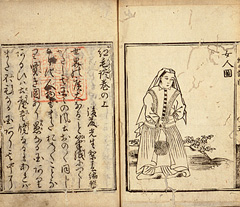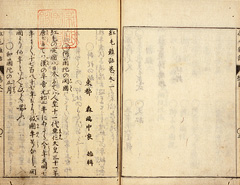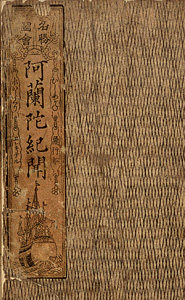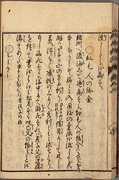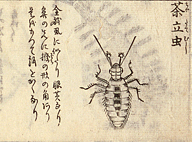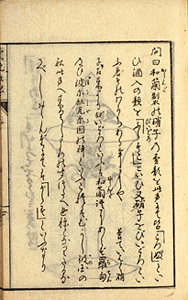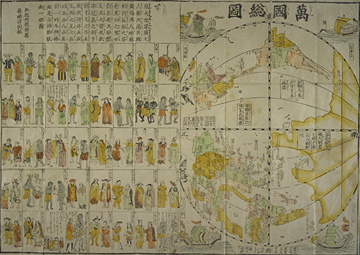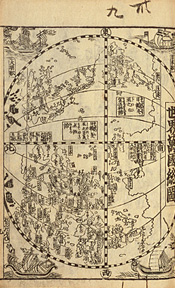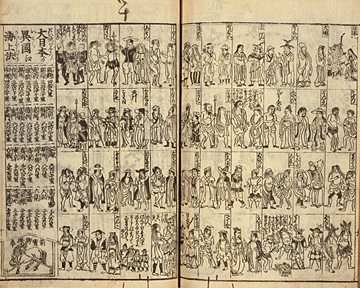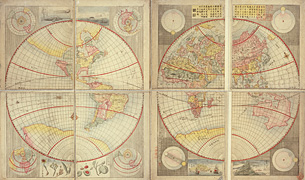Dutch studies budded out during the first half of the 18th century under the reign of Tokugawa Yoshimune, and interest in the Netherlands and other countries increased, which eventually led to the publication of books for the general public. This book is one of the early ones and covers Dutch customs, geography, fauna and flora, etc. It is also known as the first book to introduce the Elekiter (a static electricity generator). The author, Goto Mitsuo (Rishun, 1696-1771), was a herbalist.
Part 2: View by Topics 4. Receiving Knowledge from Overseas (1) Learning about Foreign Countries (1)
Home | Part 2: View by Topics | 4. Receiving Knowledge from Overseas (1) Learning about Foreign Countries (1)
Part 2: View by Topics
4. Receiving Knowledge from Overseas
(1) Learning about Foreign Countries (1)
This chapter introduces the reception of foreign knowledge, focusing on the general and illuminative books.
General Books
The idea of a 'Closed Country' may give the impression that Japan was utterly closed to foreign information, but that is not necessarily so, and people had their eyes turned toward the world through general books.
Komo zatsuwa.
Edited by Morishima Churyo. Osaka: Kawachiya Nisuke, etc., 1787? 2 v. <特1-1921>
The author, Morishima Churyo (1754-1810), was the younger brother of Katsuragawa Hoshu, a physician who served the Shogunate, and was involved in a wide range of activities including being a physician, play writer, and writer of comic poems. This book introduces new knowledge obtained from Hoshu's meeting with Dutchmen in a way that was easy for the general public to understand. The draak (dragon) picture drawn by Churyo is of a lizard given to him by C. P. Thunberg. There is also a picture of a badminton shuttlecock and racket. The illustrations of things seen through a microscope (illustrated by Shiba Kokan) included not only things that he actually saw, such as rice and poppy seeds, but also those copied from a book by J. Swammerdam. The picture of a mosquito was used in illustrations in picture books and nishiki-e prints. The 'Jinbutsu katsudo no shiki' used Gerard de Lairesse's Het groot schilderboek (Daigahosho) as a reference.
Komo zatsuwa.
Edited by Morishima Churyo. S.l.: s.n., 1787? Reissue. 5 v. in 1. <211-70>
Column: Wages of the Komo jin (Redheads)
Reading Komo zatsuwa, we can see that the Japanese asked the Dutch a variety of questions with great curiosity and received answers in return. One of the subjects was the 'Wages of the Dutch,' which introduces the very interesting topic of how the Dutch traders going to many different countries would take their large incomes. It says that after subtracting the portion needed for daily expenses, the trader entrusted the rest with a "general" (general manager) to be used as the principal for loans on which the trader would receive the principal with interest if he made it back home safely, or that would be inherited by his son if "he drowned and died at sea." This was a story heard by Otsuki Gentaku (refer to the next entry and the chapter on Dutch studies scholars)
Column: Psocid
The pictures of insects seen through a microscope contained in Komo zatsuwa are famous, but illustrations that are often introduced in addition to those of the mosquito and mosquito larva are that of the psocid. The psocid is a pest that eats the glue in books, etc., and has been found in the pest countermeasures trap surveys conducted by the National Diet Library (Trap survey report) (Japanese). Komo Zatsuwa states, "It uses the horn shaped projection on its nose to shred paper" showing that this insect has been known to eat paper since old times.
Ransetsu benwaku.
Dictated by Otsuki Gentaku. Written by Arima Bunchu. Seishu: Yamagataya Tosuke, 1799. 1 v. <特1-2992>
This is a record of the answers given by Otsuki Gentaku to the questions asked by his pupils. As noted in the postscript, "There have been many mistakes made in the transmission and reception of information," this was the popular version of the Ran'en tekiho and was an attempt to correct some of the errors that accompanied the spread of Dutch studies, such as that the Dutch were short-lived.
World Map
The shapes that are used to draw the world reflect the people's perception of the world. Scientific world maps were also more widespread in Japan in the Edo period than might have been expected.
Bankoku sozu.
Kyoto: Hayashi Jizaemon, 1671. 1 fold. sheet. <WA46-2>
The first world map published in Japan was one in 1645. This map is a popular version of that first one and has the pronunciations written over the Chinese characters in the preface and on the map. As the next entry shows, these types of world maps and ethnic groups were often included in Japanese dictionaries for the general public. These maps are thought to be based on the older maps of the West obtained during the age of trade with Portugal and from the world map by Matteo Ricci (1552-1610) obtained by way of China, rather than a Bleau's map that the Dutch brought.
Daifuku setsuyoshu daizo hokan.
Kyoto: Umemura Ichibei, 1761. 1 v. <特2-676>
Setsuyoshu is a Japanese language dictionary first created during the Muromachi period. During the Edo period, the publishers greatly revised and enlarged the content to the point where it became widely used as a family encyclopedia. In addition to the dictionary section, this book contains a practical knowledge section covering such subjects as annual events and family crests, as well as a map of Japan, map of Kyoto, and a world map and an ethnic encyclopedia that followed the pattern of Bankoku sozu. Since it was prohibited for Japanese to sail to foreign lands, Japanese could not actually go overseas. So, for the most Japanese, the world outside of Japan might be more like a virtual world than a real one. It is very interesting that a book containing a world map along with maps of Kyoto and Edo would become popular among general households. The world map was appeared in the setsuyoshu from the Genroku period (1688-1703).
Chikyu zenzu.
Copied and etched by Shiba Kokan. S.l.: s.n., c.1794. 1 fold. sheet. <亥ニ-53>
Shiba Kokan (1747-1818) was the first in Japan to use copperplate etching to print a world map, and the shape of the map clearly shows that the earth is spherical. Shiba Kokan was a painter, but was interested in Dutch studies due to the influence of Hiraga Gennai, and he was the first to make the copperplate etchung prints in Japan and he also focused on introducing Western scientific knowledge.
Navigation
-

-

-
Study of Japan by
Foreigners Coming to
Japan -
Activities of Dutch Studies
Scholars -
Studying the Dutch
Language -
Receiving Knowledge form
Overseas-
(1) Learning about
Foreign Countries-
(1) Learning about
Foreign Countries (1) -
(1) Learning about
Foreign Countries (2)
-
(1) Learning about
-
(2) Foreign Countries in
Daily Life
-
(1) Learning about
-
Acceptance of Western
Military Science at the
End of the Edo Period -
Students Studying in the
Netherlands at the End of
the Edo Period
-
Study of Japan by
Copyright © 2009 National Diet Library. Japan. All Rights Reserved

